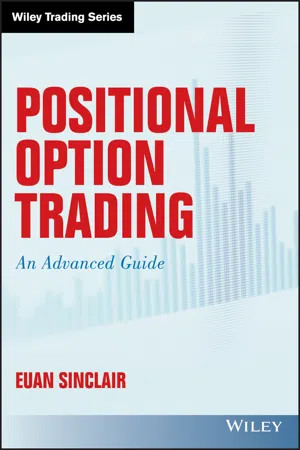
- English
- ePUB (mobile friendly)
- Available on iOS & Android
About this book
A detailed, one-stop guide for experienced options traders
Positional Option Trading: An Advanced Guide is a rigorous, professional-level guide on sophisticated techniques from professional trader and quantitative analyst Euan Sinclair. The author has over two decades of high-level option trading experience. He has written this book specifically for professional options traders who have outgrown more basic trading techniques and are searching for in-depth information suitable for advanced trading.
Custom-tailored to respond to the volatile option trading environment, this expert guide stresses the importance of finding a valid edge in situations where risk is usually overwhelmed by uncertainty and unknowability. Using examples of edges such as the volatility premium, term-structure premia and earnings effects, the author shows how to find valid trading ideas and details the decision process for choosing an option structure that best exploits the advantage.
Advanced topics include a quantitative approach for directionally trading options, the robustness of the Black Scholes Merton model, trade sizing for option portfolios, robust risk management and more. This book:
- Provides advanced trading techniques for experienced professional traders
- Addresses the need for in-depth, quantitative information that more general, intro-level options trading books do not provide
- Helps readers to master their craft and improve their performance
- Includes advanced risk management methods in option trading
No matter the market conditions, Positional Option Trading: An Advanced Guide is an important resource for any professional or advanced options trader.
Frequently asked questions
- Essential is ideal for learners and professionals who enjoy exploring a wide range of subjects. Access the Essential Library with 800,000+ trusted titles and best-sellers across business, personal growth, and the humanities. Includes unlimited reading time and Standard Read Aloud voice.
- Complete: Perfect for advanced learners and researchers needing full, unrestricted access. Unlock 1.4M+ books across hundreds of subjects, including academic and specialized titles. The Complete Plan also includes advanced features like Premium Read Aloud and Research Assistant.
Please note we cannot support devices running on iOS 13 and Android 7 or earlier. Learn more about using the app.
Information
CHAPTER 1
Options: A Summary
Option Pricing Models
Table of contents
- COVER
- TABLE OF CONTENTS
- INTRODUCTION
- CHAPTER 1: Options
- CHAPTER 2: The Efficient Market Hypothesis and Its Limitations
- CHAPTER 3: Forecasting Volatility
- CHAPTER 4: The Variance Premium
- CHAPTER 5: Finding Trades with Positive Expected Value
- CHAPTER 6: Volatility Positions
- CHAPTER 7: Directional Option Trading
- CHAPTER 8: Directional Option Strategy Selection
- CHAPTER 9: Trade Sizing
- CHAPTER 10: Meta Risks
- CONCLUSION
- APPENDIX 1: Traders' Adjustments to the BSM Assumptions
- APPENDIX 2: Statistical Rules of Thumb
- APPENDIX 3: Execution
- REFERENCES
- INDEX
- END USER LICENSE AGREEMENT